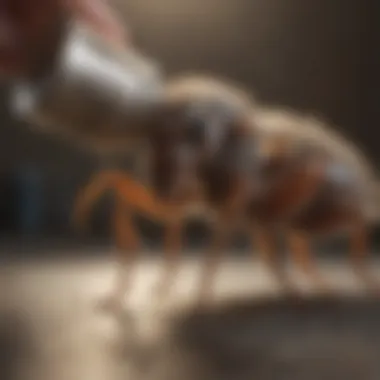Effective Flea Control: Sprays to Eliminate Fleas


Intro
Flea infestations in homes are a common nightmare for many homeowners. These tiny pests are not only annoying but can also bring discomfort to both humans and pets. Effective flea control requires a multifaceted approach, with sprays being a crucial component. In this article, we will explore spray options for controlling fleas in your house, detailing the effectiveness, safety, and application methods of both chemical and natural solutions. The aim is to equip homeowners with the knowledge needed for systematic flea management.
Pest Identification
Identifying the pests is the first step toward effective control. Fleas belong to the family Ceratophyllidae and are small, wingless insects. Their size ranges from 1/16 to 1/8 inches, making them hard to spot. The most common flea species encountered in households is the cat flea, Ctenocephalides felis.
Detailed Descriptions of Common Pests
Fleas are characterized by their dark brown to black coloration and elongated bodies, allowing them to maneuver through fur or grass with ease. Their bodies are flattened, facilitating movement in dense spaces. Additionally, these pests have distinct mouthparts adapted for piercing skin and sucking blood from their hosts.
Signs and Symptoms of Infestations
Recognizing a flea infestation can sometimes be a challenge. Here are some telltale signs:
- Itchy, irritated skin, particularly in pets.
- Presence of flea droppings, which resemble small black specks.
- Observing fleas jumping on pets or humans.
If you notice any of these signs, it��’s imperative to act quickly.
Prevention Strategies
Once the pests are identified, the next step is prevention. Sustainable pest management involves maintaining an environment less conducive to flea reproduction.
Home Maintenance Tips for Pest Prevention
- Regular Cleaning: Vacuum frequently, ensuring to get under furniture and other hard-to-reach areas where fleas might hide.
- Wash Bedding: Clean pet bedding and any linens in hot water regularly to eliminate flea eggs and larvae.
- Seal Cracks: Inspect the home for potential entry points and seal any cracks or gaps.
Natural Deterrents and Barriers
Several natural substances can act as barriers to fleas. These include:
- Diatomaceous earth, effective when sprinkled around areas of infestation.
- Essential oils like lavender and peppermint can repel fleas when diffused or used in cleaning solutions.
Treatment Options
When prevention fails, it may be necessary to treat the property.
Overview of Chemical vs. Natural Treatments
Choosing between chemical and natural treatments often depends on the severity of the infestation and personal concerns about safety. Chemical sprays, often containing pyrethroids, are effective but may pose risks to humans and pets if not used properly. Alternatively, natural sprays using essential oils are generally safer but can be less effective in severe cases.
Step-by-Step Guides for DIY Treatments
- Chemical Treatment:
- Natural Treatment:
- Choose a flea spray designed for indoor use.
- Follow the manufacturer’s instructions.
- Ensure to ventilate the area and keep pets out during treatment.
- Mix equal parts of water and white vinegar in a spray bottle.
- Lightly mist areas where fleas are more prevalent.
- Ensure the solution doesn’t saturate surfaces but lightly dampens.
Important: Always test any solution on a small area first to avoid damage.
Closure
Flea control in the house involves proper identification and timely treatment of infestations. By employing effective sprays and understanding prevention strategies, homeowners can significantly reduce the likelihood of more severe problems. This guide offers a practical approach to flea management, suitable for anyone looking to maintain a healthier living environment.
Prelude to Flea Infestations
Flea infestations are often underestimated in households. These small parasites can cause significant discomfort not just to pets but also to humans. As we explore the topic of flea control, it becomes clear that understanding fleas and their behaviors is essential. This knowledge enables homeowners to take effective measures against them.
Fleas are resilient creatures that reproduce rapidly. Therefore, being aware of the specific strategies for control is crucial. This article aims to equip readers with practical knowledge about sprays that can be used to combat flea problems within the home.
Understanding Fleas


Fleas are wingless insects belonging to the order Siphonaptera. They are known for their ability to jump long distances and feed on the blood of their hosts. Typically, pets like cats and dogs are the main targets, but humans can also be affected if the infestation is severe.
A single female flea can lay hundreds of eggs in a short period. These eggs can fall off in carpets, bedding, and other areas, leading to hidden infestations. Adult fleas can live for several months, making eradication challenging. Understanding their life cycle helps in devising effective treatments for your home.
Signs of a Flea Infestation
Detecting fleas early can prevent a larger problem. Look for these common signs that indicate an infestation:
- Flea Dirt: This is the term for flea droppings, appearing like small black specks. It can be found on pet bedding or carpets.
- Scratching or Biting: Pets may scratch more than usual. Observing this behavior can help ascertain if fleas are present.
- Visible Fleas: Adult fleas are small and dark. They can be seen moving through your pet’s fur or on the skin.
- Allergic Reactions: Some pets have allergies to flea bites. You may notice red spots or irritation on exposed skin.
Early identification of flea signs allows for quick action, minimizing the discomfort experienced by pets and owners alike.
By being vigilant and understanding signs of flea presence, prompt measures can be taken. This proactive approach is essential in ensuring that flea problems do not escalate into a much larger issue.
The Importance of Effective Flea Control
Flea infestations pose a significant challenge for many households. Understanding the importance of effective flea control is essential for maintaining a healthy living environment. Fleas are not just a nuisance; they can lead to health risks for both humans and pets. This section explores the various aspects and implications of proper flea management.
Health Risks Associated with Fleas
Fleas can cause various health issues that extend beyond mere discomfort. They are known vectors for several diseases. For instance, fleas can transmit diseases such as typhus and tapeworms. In addition, their bites can lead to itching and skin irritations. This is particularly problematic for children and individuals with sensitive skin. Furthermore, fleas can exacerbate pre-existing conditions like asthma or allergies, leading to more complex health challenges.
It's important to recognize that the consequences of flea bites are not limited to allergic reactions; they also lead to secondary infections due to scratching. Protecting your home against fleas is not only about comfort, but also about safeguarding health.
Consequences of Inadequate Treatment
Ineffective flea control measures can result in serious repercussions. When an infestation is not adequately addressed, the problem often worsens over time. Fleas reproduce quickly, which means that a small number can grow into a significant population in a short period.
Neglecting flea control can lead to an environment where fleas thrive. This can result in an infestation that is harder and more costly to treat. In severe cases, the stress and anxiety associated with living in a flea-infested home can take a toll on mental well-being. Homeowners may face ongoing discomfort and irritation, not to mention the potential for substantial cleanup efforts.
"Flea control is not just a seasonal task; it’s an ongoing commitment to maintain a healthy home environment."
Thus, timely and effective measures are crucial. A proactive approach can prevent a minor issue from escalating into a major concern. Having a solid flea control strategy ensures your home remains a comfortable and safe space for you and your family.
Types of Sprays for Flea Control
Effective flea control begins with understanding the available options for sprays that can be utilized within the home. This section discusses the two primary categories of sprays: chemical and natural. Each type has its distinct properties, benefits, and potential drawbacks. A comprehensive understanding of these sprays is crucial for making informed choices about flea control methods.
Chemical Flea Sprays
Chemical flea sprays are often popular choices due to their strong effectiveness and rapid action in eliminating fleas.
Types of Chemical Insecticides
The types of chemical insecticides typically used in flea sprays include pyrethroids, neonicotinoids, and insect growth regulators (IGRs). These substances work in different ways to combat flea populations.
Key Characteristics: Pyrethroids, derived from chrysanthemum flowers, are known for their quick knockdown effects. Neonicotinoids target the nervous system of fleas, providing a powerful impact. IGRs focus on interrupting the flea life cycle by preventing larvae from maturing, hence reducing future infestations.
Advantages: Chemical sprays often deliver immediate results. They can successfully eliminate both adult fleas and their larvae, crucial for effective control. Additionally, IGRs help manage reinfestations.
Disadvantages: However, the use of chemical sprays may introduce concerns about safety for pets and children, as well as the potential impact on the environment.
Application Guidelines
Following the application guidelines is essential for safe and effective treatment of flea infestations. This involves proper planning, execution, and following up with maintenance.
Key Characteristics: Guidelines typically include strategies such as shaking the spray can well before use, applying evenly across carpets, upholstery, and any areas where pets frequent.
Advantages: When applied properly, these sprays offer thorough coverage and maximum effectiveness, ensuring that fleas are targeted in various stages of their lifecycle.
Disadvantages: If not followed correctly, households may experience incomplete treatments, risking ongoing infestations.
Safety Precautions


Safety precautions are critical to protecting both human occupants and pets during the flea spray application process.
Key Characteristics: Users should wear protective gear, such as gloves and masks, and ensure good ventilation in the areas being treated. Pets and children should be kept away during the spraying and until drying is complete.
Advantages: These measures reduce the risks of exposure and potential health risks associated with the chemicals.
Disadvantages: Stringent safety measures might limit the areas accessible during treatment, potentially causing inconvenience.
Natural Flea Sprays
Natural flea sprays offer an alternative for those seeking less chemical-intensive options. They often incorporate essential oils and homemade recipes.
Essential Oils Use in Flea Control
The use of essential oils in flea control has gained popularity due to their natural properties and pleasant scents. Commonly used oils include lavender, peppermint, and eucalyptus.
Key Characteristics: These oils can disrupt flea behavior and act as repellents, naturally reducing flea populations when applied effectively.
Advantages: They provide a non-toxic approach that is safer for homes with pets and children. Additionally, they pose a lower environmental risk.
Disadvantages: However, essential oils may not work as quickly or efficiently on high-level infestations compared to chemical options.
Homemade Natural Solutions
Homemade natural solutions for flea control use common household ingredients, such as vinegar and dish soap, mixed with water in spray bottles.
Key Characteristics: These solutions aim to repel fleas or eliminate them on contact. They offer a cost-effective and resourceful method for management.
Advantages: The ease of preparation and low-cost materials make homemade solutions accessible to many homeowners.
Disadvantages: Their effectiveness can vary based on the infestation's severity, and they may need to be applied more frequently.
Effectiveness Compared to Chemical Options
When discussing the effectiveness of natural sprays compared to chemical ones, it is essential to consider various factors.
Key Characteristics: Chemical sprays often deliver immediate results against adult fleas, while natural options may have a longer-term, more gradual effect. Comparisons should consider effectiveness, safety, and overall impact on household health.
Advantages: Natural sprays may appeal to environmentally conscious homeowners and provide a gentler approach to pest management.
Disadvantages: For more significant infestations, relying solely on natural sprays may result in inadequate control and frustration.
Ultimately, understanding the differences between chemical and natural sprays is vital for selecting the appropriate flea control solution for your home.
Choosing the Right Spray for Your Home
Choosing the right spray for flea control in your home is a critical step in effectively managing a flea infestation. With various options available, understanding the nuances of each type can have a significant impact on treatment success. Several factors must be considered to select a suitable spray that fits your household needs. The right choice not only enhances efficacy but also ensures the safety of family members and pets, making it an essential aspect of flea control.
Factors to Consider
Size of the Infestation
The size of the infestation plays a vital role in determining the type of spray to use. A large infestation may require more potent chemical sprays, while smaller infestations can sometimes be managed with natural solutions. It is important to assess the extent of the problem before making a decision.
- Key Characteristic: The extent of flea population will guide the strength of treatment needed. A larger area might need a different approach than a smaller, localized problem.
- Consideration: Recognizing a larger flea population can mean an increase in fleas in hard-to-reach spots. Chemical sprays tend to offer more immediate action, which may be necessary in demanding situations.
- Advantage: Using the right spray based on the size ensures effective coverage and potential elimination of fleas at all life stages, which is crucial for lasting results.
Presence of Pets and Children
Consideration of pets and children in the house is crucial when selecting flea sprays. Many chemical options may pose health risks to pets and young children, necessitating careful evaluation of products.
- Key Characteristic: The presence of vulnerable family members can restrict the choice of certain harsh chemicals, leading to a preference for safer, natural options.
- Consideration: Chemical sprays may require more explicit precautions, such as suggesting a temporary relocation for pets during treatment. Understanding potential side effects becomes more critical than ever.
- Advantage: Natural sprays often provide a more gentle approach, making them better suited for homes with pets and small children, thus increasing household safety overall.
Environmental Concerns


Environmental considerations also factor into the decision about which flea spray to use. Many homeowners are increasingly aware of the potential impacts that pesticides can have on both the ecosystem and indoor air quality.
- Key Characteristic: Environmental impact is an important aspect, especially for households striving for a greener lifestyle.
- Consideration: Some chemical sprays may leave harmful residues and could contribute to air and soil pollution. Natural alternatives often reduce this risk significantly by using biodegradable ingredients.
- Advantage: Opting for environmentally-friendly products can enhance safety at home and reduce ecological footprints, aligning with the values of many responsible homeowners.
Consulting with Pest Control Professionals
When in doubt, consulting with pest control professionals is often a wise step. They can provide tailored advice based on individual situations, helping homeowners understand their specific pest issues thoroughly. These experts can guide selection based on real-world experience and knowledge about local flea development patterns, ensuring an informed choice is made. Their insights can clarify the best practices for application and safety, ensuring the effectiveness of selected sprays while minimizing risks.
Application Techniques
Application techniques are vital to ensure that flea control methods are effective in achieving desired results. Proper application can drastically reduce flea populations and minimize the chances of reinfestation. Understanding how to prepare your space before applying any spray method makes a significant difference in the overall effectiveness of your flea control efforts.
Preparing Your Space for Treatment
Cleaning and Vacuuming
Cleaning and vacuuming create an environment less conducive to flea survival. This process involves removing debris, dust, and flea eggs that are often hidden in carpets and upholstery. With thorough vacuuming, you not only remove adult fleas but also potential eggs, thus breaking the infestation cycle.
This cleaning step is a popular choice due to its dual benefits: removing visible dirt while also targeting fleas. One unique feature of this approach is its immediate impact. After vacuuming, you often see a reduction in flea activity, which is rewarding. However, it is important to dispose of the vacuum bag or empty the canister outside your home to prevent fleas from re-entering your space.
Protecting Furniture and Belongings
Protecting furniture and belongings is critical in the flea control process. When preparing for treatment, it is necessary to cover or relocate items that may come in contact with the spray. This act not only preserves the condition of your valuables but also ensures that they do not impede the application process.
A key characteristic of this method is its preventive nature. By safeguarding items, you are minimizing the risk of damage from chemicals or natural ingredients used in sprays. Unique to this approach is the attention to details, such as using drop cloths or plastic coverings to shield furniture. On the downside, it requires extra effort and time to prepare, which may discourage some homeowners.
Spraying Techniques for Maximum Effectiveness
For maximum effectiveness, it is essential to adopt the right spraying techniques. This includes targeting areas where fleas are likely to hide, such as around pet sleeping spots, baseboards, and carpets. Ensure your spray covers these hotspots adequately to achieve optimal results.
When applying the spray, maintain a consistent distance from surfaces to avoid pooling, which can be ineffective or harmful. Also, applying in a sweeping motion invites even coverage, making sure every corner receives attention. Timing is also crucial; typically, treating in the evening when pets are less active ensures better absorption and less disruption.
Effective application can significantly shorten the duration of an infestation and improve long-term management of fleas in your household.
Post-Treatment Care and Maintenance
Post-treatment care and maintenance are integral parts of flea control. After administering a spray treatment, the next steps heavily influence the overall effectiveness of the solution. These actions determine whether the treatment will eradicate fleas or if there's a risk of reinfestation. Thus, understanding how to maintain the effects of the treatments is essential for long-term flea management.
Monitoring for Reinfestation
After treatment, it is critical to monitor for signs of reinfestation. Fleas have a rapid reproductive cycle, and new fleas can emerge quickly if any eggs were left untreated. One effective method is to maintain vigilance by checking common areas where fleas might develop, such as carpets, fabrics, and pet bedding. Regularly using a flashlight can help spot these tiny pests more easily. Vacuuming regularly not only helps remove adult fleas but also helps capture their eggs and larvae. It's advisable to dispose of the vacuum bag or clean the vacuum canister thoroughly afterward to prevent any potential escape.
Additional Preventative Measures
Maintaining a flea-free home is not just about applying sprays; it also involves adopting preventative strategies.
Regular Cleaning Routines
Regular cleaning routines are essential in maintaining a flea-free environment. By adopting a systematic cleaning schedule, homeowners can effectively reduce the chances of fleas returning. This can include weekly vacuuming, especially in spots where pets frequently rest. Throwing the laundry regularly, especially for pet bedding, ensures that any potential eggs are cleaned out. The important characteristic of these routines is their consistency; without regular cleaning, flea eggs can survive and hatch. Choosing to establish this routine will not only contribute to overall hygiene but will also create a difficult environment for fleas to thrive.
Advantages of regular cleaning include maintaining a fresher home and reducing allergens. The downside may emerge if cleaning is inconsistent. Once a cleaning routine is established, keeping up with it can be manageable.
Pet Treatment Solutions
Pet treatment solutions play a pivotal role in preventing fleas from returning. It is important to treat pets with veterinarian-approved flea control products regularly. These products, ranging from topical treatments to oral medications, target fleas in various life stages, reducing the likelihood of household reinfestation. The unique feature of these solutions is their ability to eliminate fleas directly on pets, removing the primary source of infestation in the home.
Using dedicated pet treatment solutions can be beneficial as they protect not only the pets but also their surroundings. However, it is essential to follow application instructions closely to avoid potential adverse reactions. Neglecting the treatment of pets could lead to fleas being constantly reintroduced into the home. In the end, integrating pet treatment solutions into the flea control strategy is vital for sustained success.
End
Recap of Key Points
- Types of Sprays: Both chemical and natural sprays have their place in flea control. Chemical sprays often provide quicker results, while natural solutions may be safer for homes with children and pets.
- Application Techniques: Proper preparation of the space is crucial for the effectiveness of any spray. Vacuuming and protecting furniture can enhance results.
- Post-Treatment Care: Monitoring for reinfestation after treatment and implementing additional prevention strategies, such as regular cleaning routines and appropriate pet treatments, can improve long-term control.
- Professional Consultation: In some cases, consulting with pest control professionals can provide tailored solutions that might be needed for severe infestations.
Final Thoughts on Flea Management
Managing fleas requires a thoughtful approach. Homeowners must weigh the benefits of different sprays and their impact on health and the environment. Solutions should fit within your lifestyle, considering factors such as presence of children or pets. Ultimately, effective flea control is achievable through diligence, informed choices, and consistent maintenance of your living space. Regular monitoring and adopting preventive measures can make a significant difference in keeping your home flea-free. Investing time and resources into effective flea management can lead to a healthier, more comfortable household.
"Actively preventing fleas is as important as eliminating them once they infest your home."
By taking all these considerations into account, homeowners can not only resolve current infestations but also prevent future ones from occurring.



